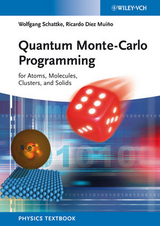Quantum Monte-Carlo Programming
Wiley-VCH (Verlag)
9783527408511 (ISBN)
- Titel leider nicht mehr lieferbar
- Artikel merken
Quantum Monte Carlo is a large class of computer algorithms that simulate quantum systems to solve many body systems in order to investigate the electronic structure of many-body systems. This book presents a numeric approach to determine the electronic structure of atoms, molecules and solids.Because of the simplicity of its theoretical concept, the authors focus on the variational Quantum-Monte-Carlo (VQMC) scheme. The reader is enabled to proceed from simple examples as the hydrogen atom to advanced ones as the Lithium solid. Several intermediate steps cover the Hydrogen molecule, how to deal with a two electron systems, going over to three electrons, and expanding to an arbitrary number of electrons to finally treat the three-dimensional periodic array of Lithium atoms in a crystal.The exmples in the field of VQMC are followed by the subject of diffusion Monte-Calro (DMC) which covers a common example, the harmonic ascillator.The book is unique as it provides both theory and numerical programs. It includes rather practical advices to do what is usually described in a theoretical textbook, and presents in more detail the physical understanding of what the manual of a code usually promises as result. Detailed derivations can be found at the appendix, and the references are chosen with respect to their use for specifying details or getting an deeper understanding .The authors address an introductory readership in condensed matter physics, computational phyiscs, chemistry and materials science. As the text is intended to open the reader's view towards various possibilities of choices of computing schemes connected with the method of QMC, it might also become a welcome literature for researchers who would like to know more about QMC methods.The book is accompanied with a collection of programs, routines, and data. To download the codes, please follow http://www.wiley-vch.de/books/sample/3527408517_codes.tar.gz
Wolfgang Schattke is a retired member of the Institut für Theoretische Physik und Astrophysik der Christian-Albrechts-University Kiel where his teaching covered the branch of theoretical physics from the basic courses to advanced topics of the PhD curriculum. His research interests focus on material properties of the solid state and its surfaces investigated with ab-initio electronic structure methods. Besides studying numerical access to photoemission spectroscopy, his scientific efforts point to many-body theory where Quantum Monte-Carlo offers a central tool to complete the successful application of Density Functional Theory to material sciences. Ricardo Díez Muino is Vice Director of the Centro de Física de Materiales, a Joint Center between the University of the Basque Country UPV/EHU and the Spanish Research Council CSIC in San Sebastian. Previously, he developed his research activity in the Donostia International Physics Center DIPC (Spain), the Lawrence Berkeley National Laboratory (USA), and the Université de Bordeaux (France). His main field of research is condensed matter theory, particularly electronic excitations in metallic systems, with some excursions into atomic and molecular physics.
A first monte-carlo example
Variational Quantum-Monte-Carlo for a One-Electron System
Two electrons with two adiabatically decoupled nuclei: Hydrogen molecule
Three electrons: Lithium Atom
Many- electron confined systems
Many- electron atomic aggregates: Lithium cluster
Infinite number of electrons: Lithium solid
Diffusion quantum Monte- Carlo (DQMC)
"The combination of both aspects allows the reader to assimilate the fundamentals of Quantum Monte Carlo not only by reading but also by practice." ( ETDE Energy Database , 1 November 2013)
| Erscheint lt. Verlag | 25.7.2013 |
|---|---|
| Sprache | englisch |
| Maße | 170 x 240 mm |
| Gewicht | 605 g |
| Themenwelt | Naturwissenschaften ► Physik / Astronomie ► Atom- / Kern- / Molekularphysik |
| Naturwissenschaften ► Physik / Astronomie ► Festkörperphysik | |
| Schlagworte | Chemie • Chemistry • Computational Chemistry & Molecular Modeling • Computational Chemistry & Molecular Modeling • Computational Chemistry u. Molecular Modeling • Festkörperphysik • Materials Science • Materialwissenschaften • Materialwissenschaften / Theorie, Modellierung u. Simulation • Mathematical & Computational Physics • Mathematical & Computational Physics • Mathematische Physik • Physics • Physik • Solid state physics • Theory, Modeling & Simulation • Theory, Modeling & Simulation |
| ISBN-13 | 9783527408511 / 9783527408511 |
| Zustand | Neuware |
| Informationen gemäß Produktsicherheitsverordnung (GPSR) | |
| Haben Sie eine Frage zum Produkt? |
aus dem Bereich




